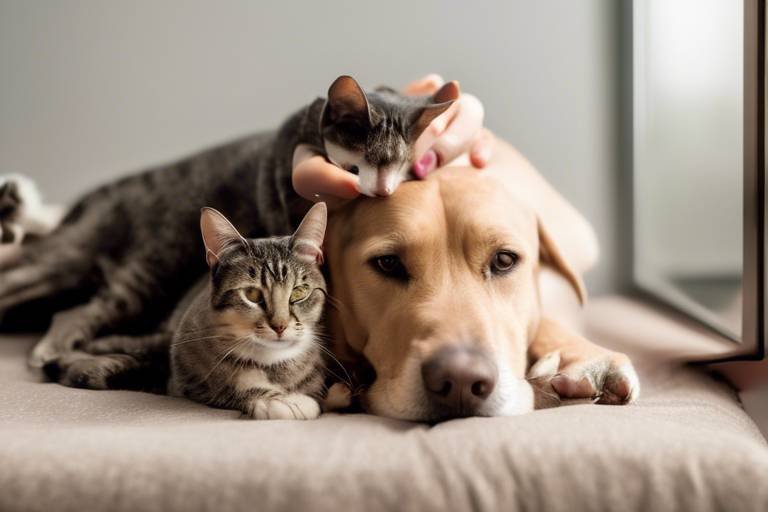Tips for Adopting a Pet from a Rural Shelter
Adopting a pet is one of the most fulfilling decisions you can make, especially when you choose to rescue an animal from a rural shelter. These shelters often house a variety of pets, each with their own unique stories and personalities. However, adopting from a rural shelter comes with its own set of challenges and rewards that can differ significantly from urban facilities. Understanding these nuances is crucial for a successful adoption experience. So, let’s dive into some essential tips that will not only help you navigate this journey but also ensure that you find the perfect furry companion.
Rural shelters are often underfunded and face challenges like limited resources and higher animal populations. This means that the animals in these shelters may not receive the same level of care or exposure as those in urban settings. Many of these shelters rely heavily on the community for support and often have passionate staff and volunteers who are dedicated to the welfare of the animals. By adopting from a rural shelter, you’re not just saving a life; you’re also supporting the local community and its efforts to care for these animals. Understanding their unique circumstances can help you make an informed decision and appreciate the journey that led your future pet to you.
Choosing the right pet is more than just falling in love at first sight; it involves a careful assessment of your lifestyle, home environment, and the specific needs of different animals. Each pet has its own personality, energy level, and requirements, which means that what works for one family may not work for another. Here are some key factors to consider:
Your daily routine is a major factor in determining which pet will be the best fit for you. Are you someone who enjoys long walks and outdoor activities? Or do you prefer cozy nights in? Understanding your activity level and family dynamics can help you align your lifestyle with the needs of various pets. For example, a high-energy dog may thrive in an active household, while a more laid-back cat might be perfect for a quieter environment.
When it comes to energy levels, it’s important to understand the pros and cons of both active and low-energy pets. Active pets, like many dogs, require regular exercise and mental stimulation. They can be incredibly rewarding companions for those who enjoy outdoor adventures. On the flip side, low-energy pets, such as certain breeds of cats or older dogs, may be more suitable for individuals or families who prefer a more relaxed lifestyle. Choosing a pet that matches your energy level can lead to a happier and more harmonious home.
If you have children or other pets, it’s essential to consider compatibility. Not all animals are suited to family life, and some may require more patience and training than others. Look for pets that have a history of being good with kids or other animals. It's also a good idea to involve your children in the process, teaching them about responsibility and empathy towards animals. This way, you can ensure that everyone in the family is prepared for the new addition.
Familiarizing yourself with common animal behaviors can significantly enhance your adoption experience. For instance, understanding that a shy dog may need time to warm up can help set realistic expectations for your new pet’s adjustment period. Observing how an animal interacts with its environment can provide insights into its past experiences and future needs. By interpreting these behaviors, you can better prepare for the challenges and joys of pet ownership.
Navigating the adoption process can be a bit daunting, especially in rural shelters. However, knowing what to expect can ease your mind and help you feel more prepared. Each shelter may have its own unique process, but there are common steps that you can anticipate.
Completing the application and participating in an interview are vital steps in the adoption process. Shelters want to ensure that their animals are going to loving homes, so be prepared to answer questions about your lifestyle, home environment, and why you want to adopt. This is also a great opportunity for you to ask questions about the animal you’re interested in and its history.
Some shelters may require home visits to ensure a suitable environment for the pet. This is not only for the safety of the animal but also to help you prepare your home for its new resident. During a home visit, shelter staff may offer valuable advice on creating a pet-friendly space, which can make the transition smoother for both you and your new pet.
Once you’ve adopted a pet, it’s essential to provide proper care and support to help them adjust to their forever home. This includes regular vet visits, a healthy diet, and plenty of love and attention. Remember, the first few weeks can be challenging as your new pet settles in, so patience is key. By providing a stable and loving environment, you’ll help your new companion thrive.
- What should I bring to the shelter when adopting? Bring identification, proof of residence, and any necessary fees.
- Can I adopt a pet if I have other animals at home? Yes, but it's important to consider compatibility and introduce them slowly.
- How can I prepare my home for a new pet? Remove hazards, create a designated space, and stock up on supplies like food, toys, and bedding.
- What if my new pet doesn't adjust well? Be patient, and consider consulting with a veterinarian or animal behaviorist for guidance.

Understanding Rural Shelters
When it comes to adopting a pet, rural shelters often present a unique landscape that differs significantly from their urban counterparts. These shelters are typically smaller, both in terms of physical space and available staff, which means they face a set of distinct challenges. One of the most pressing issues is the limited resources they have at their disposal. This can include everything from financial constraints to a lack of volunteers, which ultimately affects the care and services they can provide for the animals in their care.
Moreover, rural shelters often experience higher animal populations relative to the size of the facility. This means that you may find a greater variety of pets available for adoption, but it also means that these shelters are often stretched thin. The influx of animals can be overwhelming, and this can lead to situations where animals are not receiving the attention and care they desperately need. Understanding this dynamic is crucial for anyone considering adoption because it highlights the importance of supporting these organizations.
Another factor to consider is the community's perception of shelter animals. In rural areas, there can be a stigma attached to adopting pets from shelters, often stemming from misconceptions about their health or behavior. Many people may think that shelter animals are there because they are problematic or untrustworthy. However, this couldn't be further from the truth! Many pets end up in shelters due to circumstances beyond their control, such as owner surrender, economic hardship, or even natural disasters. By adopting from a rural shelter, you are not just giving a pet a second chance; you are also helping to change the narrative around shelter animals in your community.
In addition to these challenges, rural shelters often have a strong sense of community. They rely heavily on local support and often have close relationships with their adopters and volunteers. This can create a warm and welcoming atmosphere, making your adoption experience feel more personal. Many rural shelters also engage in community outreach programs, providing education on responsible pet ownership and the importance of spaying and neutering. By supporting these shelters, you are also contributing to the overall welfare of animals in your area.
In summary, understanding the unique challenges that rural shelters face can help you make an informed decision when considering adoption. Not only are you saving a life, but you’re also supporting a community effort to improve the lives of animals in need. So, if you're contemplating bringing a furry friend into your home, consider visiting your local rural shelter. You might just find the perfect companion while making a meaningful difference in the lives of countless animals.
- What types of animals are typically available for adoption in rural shelters?
Rural shelters usually have a variety of animals, including dogs, cats, and sometimes even small mammals or farm animals. - How can I support my local rural shelter besides adopting?
You can volunteer, donate supplies or funds, or participate in community events that raise awareness about the shelter's needs. - Are the animals in rural shelters healthy?
Most shelters ensure that animals are vaccinated and checked by a veterinarian before adoption. However, it's always good to ask about the animal's health history.

Choosing the Right Pet
When it comes to adopting a pet, making the right choice is crucial—not just for you, but for your new furry friend as well. It's like picking the perfect puzzle piece; it needs to fit seamlessly into your life. Before you head to that rural shelter, take a moment to reflect on your lifestyle, home environment, and the unique needs of various animals. After all, bringing a pet into your home is a long-term commitment that requires careful consideration.
First off, think about your daily routine. Are you someone who loves to go on long hikes or take evening jogs? Or do you prefer cozy nights on the couch with a good book? Your activity level plays a significant role in determining which pet will thrive in your home. For instance, a high-energy dog might be a perfect match for an active individual, while a low-energy cat could be ideal for someone who enjoys a quieter lifestyle.
Next, let’s consider your home environment. Do you live in a spacious house with a big backyard, or are you in a cozy apartment? The space you have available can greatly influence the type of pet that will suit you best. Larger breeds often need more room to roam, while smaller pets can adapt to tighter spaces. Additionally, think about any existing family members—both human and animal. Compatibility is key! If you have kids or other pets, it's essential to choose a pet that will fit well into your family dynamic.
Now, let’s dive deeper into the energy levels of pets. Understanding the differences between active and low-energy animals can help you make a more informed decision. For example:
- Active Pets: These pets require plenty of exercise and mental stimulation. Breeds like Border Collies or high-energy cats often thrive in active households.
- Low-Energy Pets: Perfect for those who prefer a more laid-back lifestyle, pets like bulldogs or senior cats can be great companions without demanding too much physical activity.
Finally, take the time to learn about animal behavior. Understanding how pets communicate can significantly enhance your adoption experience. For instance, a dog wagging its tail might be excited to meet you, while a cat that hisses could be feeling threatened. Familiarizing yourself with these behaviors can help you interpret what your potential new friend is feeling, allowing for a smoother transition into your home.
Ultimately, choosing the right pet is about finding a balance that works for both you and the animal. It’s not just about selecting a cute face; it’s about ensuring that both of you can enjoy a fulfilling life together. So, take your time, do your research, and remember that the right pet is out there just waiting for you!
Q: How do I know if I’m ready to adopt a pet?
A: Consider your lifestyle, financial stability, and commitment level. Adopting a pet is a long-term responsibility that requires time, effort, and resources.
Q: What should I consider when choosing a pet for my family?
A: Assess the energy levels, temperament, and compatibility of the pet with your family dynamics. It's essential to ensure that the pet will thrive in your home environment.
Q: Can I adopt a pet if I have other animals?
A: Yes! Many pets can coexist with other animals. Just be sure to introduce them slowly and monitor their interactions to ensure a harmonious relationship.
Q: What if I have a busy lifestyle?
A: If you have a hectic schedule, consider adopting a low-energy pet that requires less attention and exercise. Cats or older dogs can be great options for busy individuals.
Assessing Your Lifestyle
When it comes to adopting a pet, one of the most crucial steps is . Think about it: bringing a furry friend into your home is like inviting a new family member. You wouldn't just choose anyone, right? You need to consider how a pet will fit into your daily routine, activity level, and overall living situation. First off, let’s talk about your daily schedule. Are you someone who works long hours, or do you have a flexible job that allows you to be home often? If you’re out of the house for most of the day, you might want to consider a pet that is more independent, like a cat, or a dog that doesn’t require constant companionship.
Next, consider your activity level. Are you an outdoorsy person who loves hiking and jogging, or do you prefer cozy nights on the couch? If you’re active, you might want to adopt a high-energy dog that can keep up with your lifestyle. On the other hand, if you enjoy a more laid-back approach to life, a low-energy pet might be the better choice. Remember, pets thrive when their energy levels align with yours. It’s like finding a dance partner; you want to be in sync!
Also, think about your family dynamics. If you have kids or other pets, their needs and behaviors will also play a significant role in your decision. For instance, some breeds are known to be more tolerant of children, while others may be more skittish or territorial. It’s essential to select a pet that not only matches your lifestyle but also complements your family’s environment. If you’re unsure, many rural shelters provide resources and advice on which animals are best suited for families.
Lastly, don’t overlook your home environment. Do you live in a small apartment or a spacious house with a yard? The amount of space you have can significantly impact your pet choice. Larger dogs typically need more room to roam, while smaller breeds can adapt to tighter spaces. Additionally, consider any restrictions from your landlord or community regulations regarding pet ownership.
In summary, assessing your lifestyle is about more than just picking a cute face. It’s about finding a pet that will fit seamlessly into your life and bring joy to both you and your new companion. So take a moment, reflect on your daily habits, and think about how a pet will fit into that picture. After all, the right match can lead to a fulfilling and long-lasting relationship!
- What should I consider before adopting a pet? Assess your lifestyle, home environment, and the specific needs of different animals.
- How do I know if a pet is right for my family? Consider compatibility with children and other pets, as well as the pet’s energy level.
- Can I adopt a pet if I work long hours? Yes, but you may want to choose a more independent pet or consider options like doggy daycare.
Active vs. Low-Energy Pets
When it comes to choosing a pet, one of the most crucial factors to consider is their energy level. This can greatly affect how well they fit into your lifestyle. Active pets, like dogs and some breeds of cats, often require a lot of exercise and mental stimulation. They thrive on playtime, long walks, and activities that challenge their minds. If you're someone who enjoys being outdoors, running, or engaging in activities that involve your furry friend, an active pet might be your perfect match. Think of them as your enthusiastic workout buddy, always ready to hit the trail or the park!
On the other hand, low-energy pets can be a fantastic choice for those who prefer a more relaxed lifestyle. These pets, such as certain cat breeds or older dogs, are content with lounging around the house, enjoying a good nap, and having occasional play sessions. They require less exercise and are usually quite happy just being by your side while you binge-watch your favorite shows. Imagine them as your cozy couch companion, providing warmth and comfort without demanding too much from you.
However, it's essential to note that both active and low-energy pets come with their own sets of pros and cons:
- Active Pets:
- Pros: Great for active individuals, encourages a healthy lifestyle, and often more trainable.
- Cons: Requires more time, energy, and resources for exercise and mental stimulation.
- Low-Energy Pets:
- Pros: Perfect for busy lifestyles, less demanding in terms of exercise, and often more relaxed.
- Cons: May require more patience in training, and some can be prone to obesity if not monitored.
Ultimately, the decision between an active or low-energy pet should be based on your personal lifestyle, living situation, and what you envision for your future together. If you have a busy schedule but still want a furry friend, a low-energy pet might be the best fit. Conversely, if you have the time and energy to devote to a more active companion, you might find that an energetic pet brings a lot of joy and excitement into your life.
Before making your final decision, consider spending time with both types of pets at your local rural shelter. This will give you a better understanding of their personalities and needs, helping you make an informed choice that will lead to a harmonious relationship.
Q: How do I know if an active pet is right for me?
A: Consider your daily routine and activity level. If you enjoy outdoor activities and have time for regular exercise, an active pet could be a great fit!
Q: What if I want a low-energy pet but still want some playtime?
A: Many low-energy pets enjoy short bursts of play! Look for breeds known for their adaptable nature.
Q: Can I have both an active and a low-energy pet?
A: Absolutely! Just ensure you can meet the needs of both pets without compromising their well-being.
Considerations for Families
When it comes to adopting a pet, families have unique considerations that can make the experience both rewarding and challenging. First and foremost, you need to think about compatibility between the pet and your family members. Not all pets are suited for a bustling household with children, and some might thrive in a quieter environment. Therefore, it's crucial to evaluate the temperament of the animals you're considering. For instance, a playful puppy might be a great fit for an active family, while an older, more relaxed dog could be better suited for a home with toddlers.
Another key factor is the age of your children. Young kids often have a lot of energy and curiosity, which can be overwhelming for some pets. You might want to consider adopting a pet that has been socialized well and is tolerant of children. On the flip side, if your kids are older and can understand the responsibilities that come with pet ownership, you might opt for a more energetic breed that can keep up with their activities.
Additionally, think about the space you have available. If you live in a small apartment, a small dog or a cat might be the best choice. Conversely, if you have a spacious yard, larger breeds or even multiple pets could thrive in that environment. Remember, each pet has its own needs, and understanding these can help you create a harmonious living situation.
It’s also important to involve your children in the decision-making process. This can be a fantastic opportunity to teach them about responsibility and empathy. Discuss what type of pet they would like and why, and ensure they understand the commitment involved in caring for an animal. This dialogue can help set realistic expectations and foster a sense of teamwork in your family.
Lastly, don’t forget to consider the long-term commitment of pet ownership. Pets can live for many years, and it's essential to think about how your family's lifestyle might change over time. Will you be moving? Are your kids likely to go off to college? These factors can impact your ability to care for a pet in the future. By addressing these considerations upfront, you can ensure a smoother transition for both your family and your new furry (or scaly) friend!
- What type of pet is best for families with young children?
Generally, medium to large breeds that are known for their gentle nature, such as Labrador Retrievers or Golden Retrievers, are great choices for families with young kids. - How can I prepare my home for a new pet?
Make sure to pet-proof your home by removing any hazardous items, securing loose wires, and ensuring that toxic plants are out of reach. - Should I adopt a puppy or an adult dog?
Consider your family's energy levels and time availability. Puppies require more training and attention, while adult dogs may already have some training and be calmer. - How can I help my new pet adjust to our home?
Provide a quiet space for your pet to retreat to, establish a routine, and be patient as they acclimate to their new environment.
Understanding Animal Behavior
When you're thinking about adopting a pet, understanding animal behavior is crucial. Just like people, animals have their own personalities and quirks, which can be influenced by their past experiences, environment, and genetics. By familiarizing yourself with common behaviors, you can make a more informed decision and ensure a smoother transition for both you and your new furry friend. After all, adopting a pet is like entering into a new relationship; it requires understanding, patience, and love.
One of the first things to consider is how an animal's behavior can reflect its background. Many pets in rural shelters come from challenging situations, such as neglect or abandonment. These experiences can lead to certain behaviors, such as fearfulness or aggression. For instance, a dog that cowers when you approach may have been mistreated in the past. Understanding this can help you approach your new pet with empathy and care, allowing them to feel safe and secure in their new home.
It's also important to recognize that animals communicate through their body language. Here are some common signs to watch for:
- Tail Position: A wagging tail often indicates happiness, while a tucked tail can signal fear or submission.
- Ears: Erect ears suggest alertness, while flattened ears can indicate discomfort or aggression.
- Eyes: Direct eye contact can be a sign of confidence, but if an animal avoids eye contact, it may be feeling anxious.
Understanding these signals can help you gauge how your new pet is feeling and allow you to respond appropriately. For example, if your cat is hiding under the couch, it might just need some time to adjust to its new surroundings. On the other hand, if a dog is barking excessively, it could be a sign of anxiety or a need for attention.
Another aspect to consider is the importance of socialization. Pets, especially dogs, thrive on interaction with their humans and other animals. If a pet hasn't been properly socialized, it may struggle with new experiences, leading to anxiety or behavioral issues. Gradually introducing your new pet to different environments, people, and other animals can help boost their confidence and ease their transition into your home.
In summary, understanding animal behavior is essential for a successful adoption experience. By being aware of how a pet's past can shape its present behavior, recognizing body language, and prioritizing socialization, you can create a nurturing environment that helps your new companion thrive. Remember, patience is key; just like a flower needs time to bloom, your new pet will need time to adjust and feel at home.
Q: How can I tell if a shelter pet has been abused?
A: Look for signs such as fearfulness, cowering, or aggressive behavior. These can indicate past trauma. A good shelter will provide background information and help you understand the pet's behavior.
Q: What should I do if my new pet displays anxiety?
A: Provide a safe space for your pet, use calming aids if necessary, and gradually introduce them to new experiences. Patience and positive reinforcement can help ease anxiety.
Q: How long does it typically take for a pet to adjust to a new home?
A: Every pet is different, but it can take anywhere from a few days to several weeks for a pet to fully adjust. Be patient and give them time to explore their new environment at their own pace.

The Adoption Process
Adopting a pet from a rural shelter can be an incredibly rewarding experience, but it’s important to understand that the adoption process can differ significantly from urban facilities. Rural shelters often operate with limited resources, which means that the process may require a bit more patience and understanding. First things first, you'll need to navigate through a series of steps designed to ensure that both you and the pet are a good fit for each other. This journey can feel overwhelming at times, but breaking it down into manageable parts can make it more approachable.
One of the first steps in the adoption process is completing an application. This document usually asks for basic information about you, your living situation, and your preferences regarding the type of pet you wish to adopt. Don’t rush through this part! Take your time and think carefully about your answers. The shelter staff will use this information to help match you with a pet that suits your lifestyle. After submitting your application, you will likely be invited for an interview. This is your opportunity to discuss your application in detail. The staff will ask questions to gauge your suitability as a pet owner, and they may also share insights about the animals available for adoption.
During the interview, be prepared to answer questions such as:
- What is your experience with pets?
- Do you have any other animals at home?
- How much time can you dedicate to a new pet?
- What kind of environment do you have for a pet?
Once you’ve successfully completed the interview, the next step may involve a home visit. This is where a shelter representative comes to your home to assess whether it is a suitable environment for a pet. While this might sound intimidating, it’s primarily a way for the shelter to ensure that the animal will be safe and comfortable in your home. They will look at factors such as space, safety, and whether or not you have a suitable area for the pet to play. Remember, this is not just a formality; it’s an essential part of the process that helps ensure the well-being of the animals.
After the home visit, if everything checks out, you’ll be one step closer to bringing your new furry friend home! However, you might still need to complete a few final steps, such as paying an adoption fee, which often goes towards covering the costs of vaccinations, spaying/neutering, and other essential care that the shelter provides to the animals. This fee can vary from one shelter to another, so it’s a good idea to ask about it during your application process.
Once all the paperwork is finalized, you’ll be ready to take your new pet home! But remember, the adoption process doesn’t end when you walk out of the shelter. It’s just the beginning of a beautiful journey together. Your new pet will need time to adjust to their new environment, and it’s essential to be patient and supportive as they settle in.
In summary, while the adoption process at a rural shelter may come with unique challenges, it is also filled with opportunities for connection and joy. By understanding each step, from the application and interview to home visits and finalizing the adoption, you’ll be well-prepared to give a loving animal a forever home.
Here are some common questions that potential adopters often have:
- What should I bring to the interview? Bring any necessary documentation, such as proof of residence and references if required.
- How long does the adoption process usually take? This can vary, but typically it takes a few days to a couple of weeks, depending on the shelter's policies.
- Are there any adoption fees? Yes, most shelters require an adoption fee to help cover the costs of caring for the animals.
- What if I change my mind after adopting? Many shelters have return policies, but it's crucial to think it through before making the commitment.
Application and Interview
When it comes to adopting a pet from a rural shelter, the process serves as the gateway to bringing your new furry friend home. While it might seem a bit intimidating at first, understanding what to expect can make the experience smoother and more enjoyable. First off, you'll typically start by filling out an application form. This form is crucial as it provides the shelter with essential information about you, your lifestyle, and your expectations for a pet. Think of it as your chance to showcase your suitability as a pet parent!
During the application, you may be asked questions about your living situation, previous pet ownership experiences, and your reasons for adopting. This is not just a formality; shelters want to ensure that their animals go to loving and responsible homes. Be honest and open in your responses. If you're a first-time pet owner, don't worry! Shelters appreciate your willingness to learn and grow alongside your new companion.
Once your application is submitted, you may be invited for an interview. This is where the fun begins! The interview is not an interrogation; rather, it's a friendly conversation designed to assess your compatibility with the pet you wish to adopt. Here are a few tips to prepare:
- Be Ready to Discuss: Think about your daily routine, your household dynamics, and the type of pet you envision. This will help you articulate your thoughts during the discussion.
- Ask Questions: This is your opportunity to learn more about the animal's background, behavior, and any special needs they may have. Don't hesitate to ask anything that comes to mind!
- Show Enthusiasm: Let your passion for pet adoption shine through! Shelters love seeing potential adopters who are excited about bringing a new pet into their lives.
After the interview, some shelters may conduct a home visit to ensure that your living environment is suitable for the pet. This step is essential for the well-being of the animal. It allows the shelter to assess factors like space, safety, and any other pets you may already have. To prepare for a home visit, make sure your home is tidy and pet-friendly. You don't need to go overboard; just ensure there are no hazards that could pose a risk to your future pet.
In summary, the application and interview process is all about ensuring a good match between you and your potential pet. By being prepared and open during this phase, you’ll not only ease your own nerves but also demonstrate to the shelter that you’re ready for the responsibility of pet ownership. Remember, this is the first step towards a beautiful journey with your new best friend!
Q: How long does the application process take?
A: The application process can vary, but most shelters aim to respond within a few days to a week. Be patient, as they want to ensure the best fit for their animals.
Q: Can I adopt a pet if I have other animals at home?
A: Yes! Many shelters encourage families with other pets to adopt. Just be sure to discuss your current pets during the application and interview process.
Q: What if I don’t get approved?
A: If your application is not approved, don’t be discouraged. Shelters often provide feedback and suggestions for how you can improve your chances in the future.
Q: Are there fees associated with adoption?
A: Yes, most shelters charge an adoption fee. This fee often covers vaccinations, spaying/neutering, and other veterinary care. It's a small price to pay for the love and joy a pet brings!
Home Visits and Assessments
When it comes to adopting a pet from a rural shelter, play a crucial role in ensuring that both the animal and the adopter are set up for success. These visits are not just a formality; they are an opportunity for shelter staff to understand your living environment and for you to ask any lingering questions about your potential new furry friend. Imagine this as a first date, where both parties are trying to get to know each other better before committing to a long-term relationship.
During the home visit, a representative from the shelter will come to your home to assess various factors that contribute to a safe and welcoming environment for the pet. They will look at the space available, any potential hazards, and how you plan to integrate the new pet into your daily life. This is the perfect time to showcase your home as a haven for your future pet, so make sure to tidy up and prepare any specific areas where the pet will spend most of their time.
It's also important to remember that this isn't just a one-way evaluation. You should feel comfortable asking the shelter representative questions about the pet's behavior, health, and any special needs they may have. For example, if you're considering adopting a dog, you might want to inquire about their socialization skills or any previous training they may have received. Here are some key aspects to consider during the assessment:
- Safety: Are there any items that could pose a risk to the pet, such as sharp objects or toxic plants?
- Space: Is there enough room for the pet to roam and play comfortably?
- Comfort: Have you prepared a cozy space for the pet to relax, such as a bed or crate?
- Family Dynamics: How will family members, including children and other pets, interact with the new addition?
After the home visit, the shelter may provide recommendations or resources to help you create a pet-friendly environment. This could include tips on how to pet-proof your home or advice on transitioning the pet into their new space. Think of it as a personalized guide to making your home a sanctuary for your new companion.
In some cases, shelters may require additional assessments, particularly for pets with special needs or behavioral challenges. These assessments ensure that the pet is matched with an adopter who can meet their specific requirements, ultimately leading to a happier and healthier life for both the animal and the owner.
In conclusion, are invaluable steps in the adoption process. They not only help shelters place animals in suitable environments but also empower adopters with the knowledge they need to provide the best possible care for their new pet. So, embrace this opportunity to learn and grow as a pet owner, and remember that every effort you make now will pave the way for a fulfilling relationship with your new furry friend.
Here are some common questions that people have when considering home visits and assessments during the pet adoption process:
- What should I do to prepare for a home visit?
Make sure your home is tidy and safe for pets. Identify areas where the pet will spend time and remove any hazards. - Will the shelter provide feedback after the visit?
Yes, they often provide insights and suggestions to help you create a welcoming environment. - What if I have multiple pets?
The shelter will assess how well the new pet might integrate with your existing animals and provide guidance accordingly. - Can I ask questions during the home visit?
Absolutely! This is your chance to gather information about the pet and ensure you're making an informed decision.

Post-Adoption Care
Congratulations on welcoming a new furry friend into your home! The journey doesn’t end with adoption; in fact, it’s just the beginning. is crucial for ensuring your pet adjusts well to their new environment and thrives in their forever home. First and foremost, it’s essential to create a safe and comfortable space for your pet. This could mean setting up a cozy bed, providing toys, and ensuring that the area is free from hazards. Think of it as creating a sanctuary where your pet can feel secure and loved.
Next, establishing a routine is vital. Animals, much like humans, thrive on predictability. Feeding, walking, and playtime should occur at roughly the same times each day. This not only helps your pet feel settled but also strengthens the bond between you two. Remember, consistency is key! Just like a well-tuned clock, a routine keeps everything running smoothly.
It’s also important to focus on nutrition. A balanced diet tailored to your pet’s specific needs can make a world of difference in their health and happiness. Consult with a veterinarian to determine the best food options. For instance, puppies and kittens require different nutrients than adult pets. Here’s a quick overview:
| Pet Type | Dietary Needs |
|---|---|
| Puppies | High protein, calcium for growth |
| Kittens | Rich in protein and fat for energy |
| Adult Dogs | Balanced diet with appropriate calories |
| Adult Cats | High protein, moderate fat |
Another critical aspect of post-adoption care is socialization. Spend time getting to know your pet and allowing them to explore their new surroundings. Introduce them to different people, environments, and even other pets gradually. This helps them become well-adjusted and confident companions. Think of it as a gentle introduction to the world—like a child learning to ride a bike with training wheels before hitting the open road!
Don’t forget about regular veterinary check-ups! These visits are essential for keeping your pet healthy and up-to-date on vaccinations. Regular wellness exams can catch potential health issues early, ensuring your pet lives a long and happy life. It’s much easier to prevent problems than to fix them later, just like maintaining a car is better than waiting for it to break down.
Lastly, provide plenty of love and patience. Every pet has a unique background, and some may take longer to adjust than others. Be understanding of their quirks and behaviors, and offer reassurance during transitions. Your love is the most important ingredient in helping your new companion feel at home.
- How long will it take for my new pet to adjust? Every pet is different, but it can take anywhere from a few days to several weeks for them to settle in.
- What should I do if my pet shows signs of anxiety? Create a safe space, maintain a routine, and consult with a veterinarian if anxiety persists.
- How often should I take my pet to the vet? Regular check-ups are recommended at least once a year, or more frequently for young or senior pets.
- What if my pet doesn't get along with my other pets? Gradual introductions and supervised interactions can help ease the transition.
Frequently Asked Questions
- What should I consider before adopting a pet from a rural shelter?
Before jumping into adoption, think about your lifestyle, home environment, and the specific needs of different pets. Assess how much time you can dedicate to a new furry friend and whether you have the space for them to thrive. Remember, adopting a pet is a long-term commitment!
- Are rural shelters less reliable than urban shelters?
Not at all! While rural shelters may face challenges like limited resources and higher animal populations, they are often staffed by passionate individuals dedicated to animal welfare. These shelters can be a treasure trove of loving pets waiting for a forever home.
- How do I choose the right pet for my family?
Choosing the right pet involves considering your family's dynamics and the pet's personality. If you have kids, look for pets known for their gentleness and playfulness. Also, think about the energy levels of different breeds; some pets may be more suited for active families than others.
- What is the adoption process like at a rural shelter?
The adoption process typically includes filling out an application, participating in an interview, and sometimes undergoing a home visit. Each step is designed to ensure that both you and the pet are a good match. Don’t worry; the staff will guide you through every step!
- Will I need to prepare my home for a new pet?
Yes, preparing your home is crucial! Make sure to create a safe space for your new pet, remove any hazards, and have necessary supplies like food, water bowls, a bed, and toys ready. This will help your pet feel comfortable and welcomed in their new environment.
- How can I help my new pet adjust after adoption?
Give your new pet time to acclimate to their new surroundings. Establish a routine for feeding and walks, and be patient as they explore their new home. Providing a calm and loving environment will help them feel secure and loved.
- What should I do if my adopted pet exhibits behavioral issues?
If your new pet shows signs of anxiety or behavioral issues, it’s important to consult with a veterinarian or a professional animal behaviorist. They can provide guidance on training techniques and strategies to help your pet adjust and thrive.



















